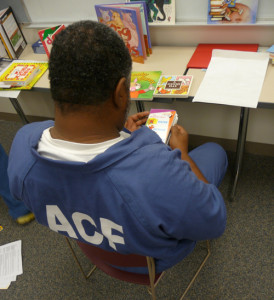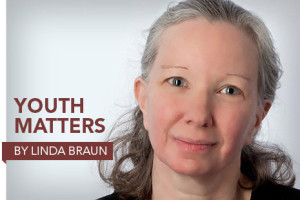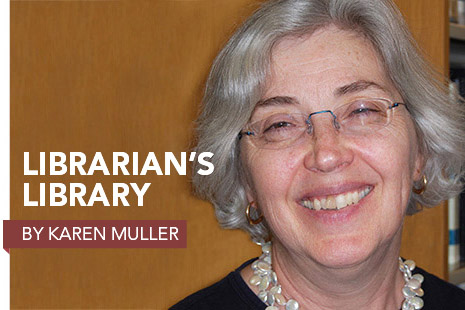
The missions of libraries, archives, and museums (LAMs) converge with a common purpose: preserving our cultural heritage. To fully understand the past, it is important to look at materials collected by LAMs as a whole, with each institution complementing the other. Artifacts in a museum should be viewed along with the source materials in an archive and the discussion or application of the learning in a library. These books cover aspects of administering LAMs, along with the ways resources in LAMs might be used to support education or personal entertainment.
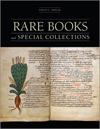 Rare book collections are not just limited to well-known libraries—they may be present in any size or type of library local history collection, or special collection surrounding an event of importance to the larger community. Sidney E. Berger’s Rare Books and Special Collections is a handbook to help an administrator understand the special aspects of these collections. It is a thorough treatment of both technical and practical considerations in working in a special collection. Each area—operations, fundraising, legal issues, book collecting, and bibliography—is clearly and authoritatively written, with illustrations and illustrative sidebars, plus bibliographies for further investigation or deeper knowledge.
Rare book collections are not just limited to well-known libraries—they may be present in any size or type of library local history collection, or special collection surrounding an event of importance to the larger community. Sidney E. Berger’s Rare Books and Special Collections is a handbook to help an administrator understand the special aspects of these collections. It is a thorough treatment of both technical and practical considerations in working in a special collection. Each area—operations, fundraising, legal issues, book collecting, and bibliography—is clearly and authoritatively written, with illustrations and illustrative sidebars, plus bibliographies for further investigation or deeper knowledge.
Indexed. Neal-Schuman, 2014. 560 P. $129. 978-1-55570-964-8
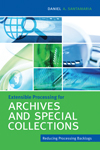 Daniel A. Santamaria’s Extensible Processing for Archives and Special Collections: Reducing Processing Backlogs provides a road map, with case studies, for preparing a baseline description of an archival holding so it can be discovered and used, and for extending the information as it is being used. Extensible processing builds on archival practices while incorporating current standards for description and needs for accommodating digital collections.
Daniel A. Santamaria’s Extensible Processing for Archives and Special Collections: Reducing Processing Backlogs provides a road map, with case studies, for preparing a baseline description of an archival holding so it can be discovered and used, and for extending the information as it is being used. Extensible processing builds on archival practices while incorporating current standards for description and needs for accommodating digital collections.
Indexed. Neal-Schuman, 2014. 248 P. $75. 978-0-8389-1257-7
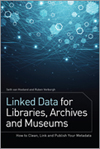 Discovery of collections is also enhanced through linked metadata. In Linked Data for Libraries, Archives, and Museums: How to Clean, Link, and Publish Your Metadata, Seth van Hooland and Ruben Verborgh provide technical details of one of the drivers of the LAMs convergence: digitization of collections and building connections between the images of the artifacts, the scans of the texts, and the finding aids in the archives.
Discovery of collections is also enhanced through linked metadata. In Linked Data for Libraries, Archives, and Museums: How to Clean, Link, and Publish Your Metadata, Seth van Hooland and Ruben Verborgh provide technical details of one of the drivers of the LAMs convergence: digitization of collections and building connections between the images of the artifacts, the scans of the texts, and the finding aids in the archives.
Indexed. Neal-Schuman, 2014. 272 P. $88. 978-0-8389-1251-5
Two books explore aspects of museum management with potential applications in a library setting. A library or archive with special collections may be interested in enhancing the 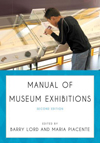 visitor’s experience by applying the guidance in Manual of Museum Exhibitions, edited by Barry Lord and Maria Piacente. In Multiculturalism in Art Museums Today, edited by Joni Boyd Acuff and Laura Evans, essays explore how a museum can follow a library’s example and lead the way as a community change agent by collaborating with diverse audiences and using educational programs to reach out to patrons.
visitor’s experience by applying the guidance in Manual of Museum Exhibitions, edited by Barry Lord and Maria Piacente. In Multiculturalism in Art Museums Today, edited by Joni Boyd Acuff and Laura Evans, essays explore how a museum can follow a library’s example and lead the way as a community change agent by collaborating with diverse audiences and using educational programs to reach out to patrons.
Indexed. Rowman & Littlefield, 2014. 456 P. $75. PBK. 978-0-7591-2270-3 (Also available as an ebook)
Indexed. Rowman & Littlefield, 2014. 380 P. $75. 978-0-7591-2410-3 (Also available as an ebook)
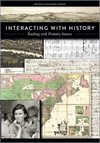 But why should a library with a public mission collect unique or rare objects? Interacting with History: Teaching with Primary Sources, edited by Katharine Lehman, looks at how special collections are used as teaching resources at the Library of Congress. In addition to the descriptions of the digital collections and finding aids available from LC, there is guidance on how to select age-appropriate materials that support the classroom curriculum, with sample lessons. The final chapter focuses on finding history resources locally—and that is where the regional archives and museums, as well as specialized holdings of public libraries, come in. There are tips on finding the collections, identifying useful content, and incorporating the collections into teaching. Flipped, this chapter might also be a guide for the librarian seeking to develop partnerships with community schools.
But why should a library with a public mission collect unique or rare objects? Interacting with History: Teaching with Primary Sources, edited by Katharine Lehman, looks at how special collections are used as teaching resources at the Library of Congress. In addition to the descriptions of the digital collections and finding aids available from LC, there is guidance on how to select age-appropriate materials that support the classroom curriculum, with sample lessons. The final chapter focuses on finding history resources locally—and that is where the regional archives and museums, as well as specialized holdings of public libraries, come in. There are tips on finding the collections, identifying useful content, and incorporating the collections into teaching. Flipped, this chapter might also be a guide for the librarian seeking to develop partnerships with community schools.
Indexed. ALA Editions, 2014. 136 P. $46. 978-0-8389-1205-8
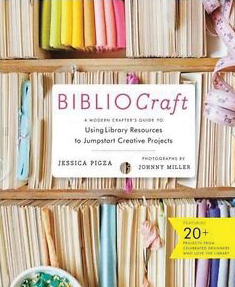 Libraries also serve to entertain, as witnessed by the emergence of makerspaces in libraries in recent years. Rare book librarian Jessica Pigza’s Bibliocraft: A Modern Crafter’s Guide to Using Library Resources to Jumpstart Creative Projects is just what the subtitle says. The 20 featured projects draw inspiration from historical material available in libraries and utilize a range of crafts—calligraphy instructions adapted to crewel embroidery, for example. The author includes a guide to finding and using libraries, along with a brief copyright primer to ensure that images and other inspirational content are used ethically.
Libraries also serve to entertain, as witnessed by the emergence of makerspaces in libraries in recent years. Rare book librarian Jessica Pigza’s Bibliocraft: A Modern Crafter’s Guide to Using Library Resources to Jumpstart Creative Projects is just what the subtitle says. The 20 featured projects draw inspiration from historical material available in libraries and utilize a range of crafts—calligraphy instructions adapted to crewel embroidery, for example. The author includes a guide to finding and using libraries, along with a brief copyright primer to ensure that images and other inspirational content are used ethically.
Indexed. STC Craft, 2014. 208 P. $27.50. 978-1-61769-096-9

